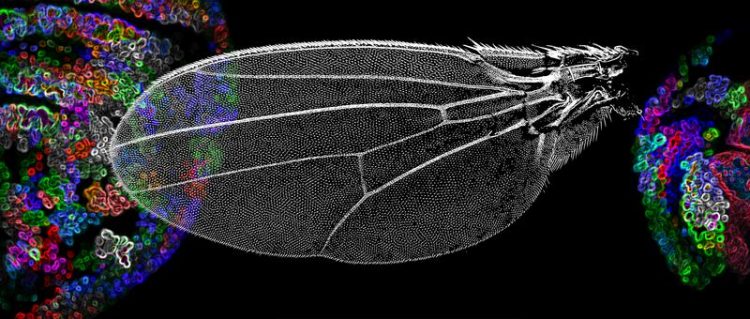Nanobodies from Camels Enable the Study of Organ Growth

Drosophila wing size control depends on the spreading of the Dpp morphogen. University of Basel, Biozentrum
The two basic processes that control organ development are the regulation of growth and of the spatial pattern. The research group of Prof. Markus Affolter at the Biozentrum, University of Basel, has now developed a method named “Morphotrap” to study wing development in the fruit fly.
Their results demonstrate that the signaling molecule Dpp, a so-called morphogen, influences growth in the center of the wing imaginal disc but not in the peripheral regions. It is the first time that an anti-GFP nanobody has been successfully employed in such an investigation. This tool also holds promise for future studies on organ development.
The new method “Morphotrap”: Nanobodies to study growth
Nanobodies are small antibody fragments derived from camels. They enable the research team of Markus Affolter to manipulate molecules in the living organism. The so-called “Morphotrap” method employs anti-GFP nanobodies. Using these Nanobodies, the functions of GFP-tagged proteins in living organisms can be studied faster and more effectively than by conventional methods.
“These anti-GFP nanobodies inhibit the dispersal of the morphogen Dpp at different locations in the wing. Therefore they allow us to identify the influence of Dpp spreading on wing growth,” explains Stefan Harmansa, the first author of the study.
Morphogen Dpp regulates growth in the middle of the imaginal disc
To determine the influence of the morphogen Decapentaplegic (Dpp) in more detail, the Affolter group examined the wing disc of the fruit fly, called the imaginal disc. This is the precursor tissue of the wing of the adult fly and serves as a model for studies on organ development.
“Our findings demonstrate that the morphogen Dpp only affects growth in the center of the imaginal disc. Growth continues in the periphery even when we fully block Dpp dispersal into this regions,” explains Harmansa. “Now, by employing anti GFP nanobodies, we have been able to show to which extent the morphogen Dpp determines the wing size and consequently we could disprove one of the two predominant theories in this field,” says Harmansa.
The fact that anti GFP-nanobodies can successfully be applied for research in complex living organism is a great achievement. Affolter also plans to apply this technique in future research: “In a next step, we will investigate at what time in development Dpp acts to control central growth. The correlation between the spatial and temporal influence of Dpp will provide new insights into organ growth and may uncover possible causes of organ malformation,” says Affolter.
Original source
Stefan Harmansa, Fisun Hamaratoglu, Markus Affolter & Emmanuel Caussinus
Dpp spreading is required for medial but not for lateral wing disc growth
Nature (2015), doi: 10.1038/nature15712
Further information
Prof. Dr. Markus Affolter, University of Basel, Biozentrum, tel. +41 61 267 20 72, email: markus.affolter@unibas.ch
Heike Sacher, University of Basel, Biozentrum, tel. +41 61 267 14 49, email: heike.sacher@unibas.ch
https://www.unibas.ch/en/News-Events/News/Uni-Research/Tuberculosis-bacteria-out…
Media Contact
All latest news from the category: Life Sciences and Chemistry
Articles and reports from the Life Sciences and chemistry area deal with applied and basic research into modern biology, chemistry and human medicine.
Valuable information can be found on a range of life sciences fields including bacteriology, biochemistry, bionics, bioinformatics, biophysics, biotechnology, genetics, geobotany, human biology, marine biology, microbiology, molecular biology, cellular biology, zoology, bioinorganic chemistry, microchemistry and environmental chemistry.
Newest articles

Innovative vortex beam technology
…unleashes ultra-secure, high-capacity data transmission. Scientists have developed a breakthrough optical technology that could dramatically enhance the capacity and security of data transmission (Fig. 1). By utilizing a new type…

Tiny dancers: Scientists synchronise bacterial motion
Researchers at TU Delft have discovered that E. coli bacteria can synchronise their movements, creating order in seemingly random biological systems. By trapping individual bacteria in micro-engineered circular cavities and…

Primary investigation on ram-rotor detonation engine
Detonation is a supersonic combustion wave, characterized by a shock wave driven by the energy release from closely coupled chemical reactions. It is a typical form of pressure gain combustion,…



